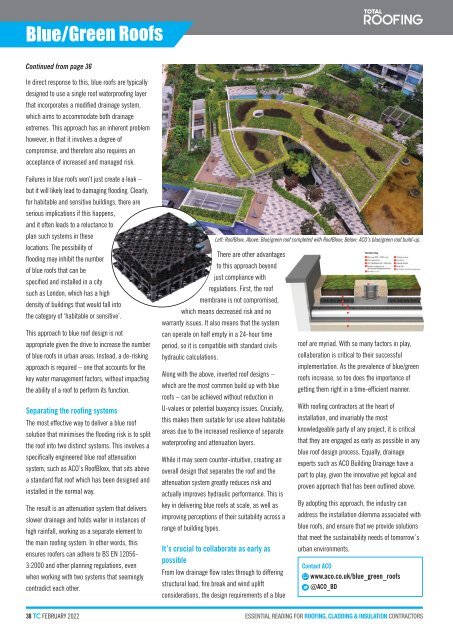February 2022
You also want an ePaper? Increase the reach of your titles
YUMPU automatically turns print PDFs into web optimized ePapers that Google loves.
Blue/Green Roofs<br />
Continued from page 36<br />
In direct response to this, blue roofs are typically<br />
designed to use a single roof waterproofing layer<br />
that incorporates a modified drainage system,<br />
which aims to accommodate both drainage<br />
extremes. This approach has an inherent problem<br />
however, in that it involves a degree of<br />
compromise, and therefore also requires an<br />
acceptance of increased and managed risk.<br />
Failures in blue roofs won’t just create a leak –<br />
but it will likely lead to damaging flooding. Clearly,<br />
for habitable and sensitive buildings, there are<br />
serious implications if this happens,<br />
and it often leads to a reluctance to<br />
plan such systems in these<br />
locations. The possibility of<br />
flooding may inhibit the number<br />
of blue roofs that can be<br />
specified and installed in a city<br />
such as London, which has a high<br />
density of buildings that would fall into<br />
the category of ‘habitable or sensitive’.<br />
This approach to blue roof design is not<br />
appropriate given the drive to increase the number<br />
of blue roofs in urban areas. Instead, a de-risking<br />
approach is required – one that accounts for the<br />
key water management factors, without impacting<br />
the ability of a roof to perform its function.<br />
Separating the roofing systems<br />
The most effective way to deliver a blue roof<br />
solution that minimises the flooding risk is to split<br />
the roof into two distinct systems. This involves a<br />
specifically engineered blue roof attenuation<br />
system, such as ACO’s RoofBloxx, that sits above<br />
a standard flat roof which has been designed and<br />
installed in the normal way.<br />
The result is an attenuation system that delivers<br />
slower drainage and holds water in instances of<br />
high rainfall, working as a separate element to<br />
the main roofing system. In other words, this<br />
ensures roofers can adhere to BS EN 12056-<br />
3:2000 and other planning regulations, even<br />
when working with two systems that seemingly<br />
contradict each other.<br />
Left: RoofBloxx. Above: Blue/green roof completed with RoofBloxx; Below: ACO’s blue/green roof build-up.<br />
There are other advantages<br />
to this approach beyond<br />
just compliance with<br />
regulations. First, the roof<br />
membrane is not compromised,<br />
which means decreased risk and no<br />
warranty issues. It also means that the system<br />
can operate on half empty in a 24-hour time<br />
period, so it is compatible with standard civils<br />
hydraulic calculations.<br />
Along with the above, inverted roof designs –<br />
which are the most common build up with blue<br />
roofs – can be achieved without reduction in<br />
U-values or potential buoyancy issues. Crucially,<br />
this makes them suitable for use above habitable<br />
areas due to the increased resilience of separate<br />
waterproofing and attenuation layers.<br />
While it may seem counter-intuitive, creating an<br />
overall design that separates the roof and the<br />
attenuation system greatly reduces risk and<br />
actually improves hydraulic performance. This is<br />
key in delivering blue roofs at scale, as well as<br />
improving perceptions of their suitability across a<br />
range of building types.<br />
It’s crucial to collaborate as early as<br />
possible<br />
From low drainage flow rates through to differing<br />
structural load, fire break and wind uplift<br />
considerations, the design requirements of a blue<br />
roof are myriad. With so many factors in play,<br />
collaboration is critical to their successful<br />
implementation. As the prevalence of blue/green<br />
roofs increase, so too does the importance of<br />
getting them right in a time-efficient manner.<br />
With roofing contractors at the heart of<br />
installation, and invariably the most<br />
knowledgeable party of any project, it is critical<br />
that they are engaged as early as possible in any<br />
blue roof design process. Equally, drainage<br />
experts such as ACO Building Drainage have a<br />
part to play, given the innovative yet logical and<br />
proven approach that has been outlined above.<br />
By adopting this approach, the industry can<br />
address the installation dilemma associated with<br />
blue roofs, and ensure that we provide solutions<br />
that meet the sustainability needs of tomorrow’s<br />
urban environments.<br />
Contact ACO<br />
www.aco.co.uk/blue_green_roofs<br />
@ACO_BD<br />
38 TC FEBRUARY <strong>2022</strong>

















